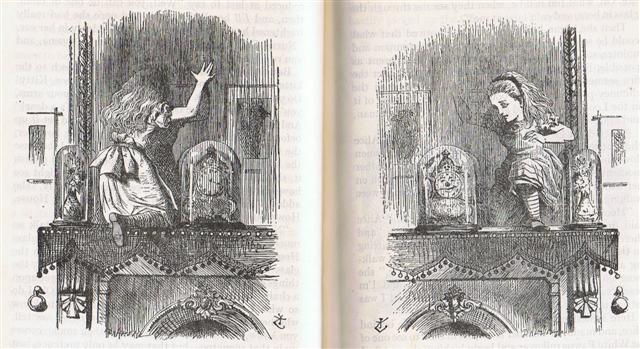At Gb2-1 there is a reversal compared to the picture in Gb1-26:
The arm going in from the front in Gb2-1 could represent the 'left arm of Sun' (looking down on us). Whereas it would then be his right hand which is inside henua in Gb1-26 (perhaps visualizing how Sun has 'gone down' in the west). The 'fist' at the end of this type of 'arm' is presumably not such but the part of the arm connecting to the body. The open right hand is similar to a flower (with its petals like fingers, or rays, surrounding a round disc), and the peculiar rau hei (Mimosa) species comes to mind. Furthermore, the arm pit (rua) is a center of creation: ... In the beginning there was nothing but the sea, and above soared the Old-Spider. One day the Old-Spider found a giant clam, took it up, and tried to find if this object had any opening, but could find none. She tapped on it, and as it sounded hollow, she decided it was empty. By repeating a charm, she opened the two shells and slipped inside. She could see nothing, because the sun and the moon did not then exist; and then, she could not stand up because there was not enough room in the shellfish. Constantly hunting about she at last found a snail. To endow it with power she placed it under her arm, lay down and slept for three days ... The Mayan closing (biting) hand (Chikin) at the horizon in the west is the opposite of the open flowery hand in the east: ... The horizon in the west is where Sun disappears in late afternoon. In the morning when Sun reappears in the east he is like a newborn baby, at noon he is standing tall, and in the afternoon he shrinks - he is growing old. His disappearance in the west was called 'the biting of the sun' (Chikin) by the Maya:
399 at Gb1-26 can refer to the synodical cycle of Jupiter (Father Light). In Gb2-1 his 'hand' would then have gone down in the east, which probably means the 'left arm of Sun' can be identified with 'Moon' (he has changed sex from male to female). Sun has only one visible 'wing' and therefore it cannot be the arm of Sun himself in Gb2-1. Evidently this personality change from 'Sun' to 'Moon' occurs in day 400 according to the Gregorian calendar, but according to the manzil system the day number is 264. Februarius was the month when Sun and Moon had to be coordinated, come together, and their common efforts to create a new 'world' would occur inside (in the dark). The expression ki roto means 'into' and refers to copulation. ... a 27-day intercalary month, the Mensis Intercalaris, was sometimes inserted between February and March. This intercalary month was formed by inserting 22 days after the first 23 or 24 days of February; the last five days of February, which counted down toward the start of March, became the last five days of Intercalaris. The net effect was to add 22 or 23 days to the year ... ... Marcus Antonius, who this year was consul together with Ceasar, became high priest and responsible for the ceremonies. In the middle of February, at the time of the old feast of Lupercalia, he ran around naked (except for a girdle - like a maro), and whipped the Roman ladies with thongs made from goat-skin, in order to promote ('kick' - Rei), their fertility ...
Counting from solstice in 'June 21 (172) there are 228 days (15 right ascension hours) to day 400 ('February 4):
229 is one more and equal to the number of glyphs on side a of the tablet. 229 could be a Sign meaning we should no longer think in terms of right ascension (stars rising together with Sun) but instead should consider their midnight culminations. This seems to be in harmony with the expired 'Sun Flower' sign in Gb2-23 (250 days after 'June 21). Presumably more important is the fact that the last part of the right ascension cycle stretches for 46 days beyond day 399 (365 + 80 = 399 + 46). However, rau hei in Gb1-25 is located 226 days after 'June 21. And for stars with heliacal risings in June their midnight culminations would be around 226 days later, not 229 days later:
229 days could point at stars rising heliacally in the 4th quarter of the Gregorian year and their culminations would then be somewhere beyond April, for instance would Gienah (γ Corvi) have culminated at midnight around 'May 9 (129) at the time of G:
265, the Gregorian day number for 'September 22 (autumn equinox), is a date 136 days later than 'May 9, 129 + 136 = 265 (100 less than 365). However, from 'September 22 to 'May 9 the following year there are 365 + 129 - 265 = 229 days. The manzil system has its first day in May 17 = day 136 + 1 counted from January 1. Number 136 is connected with number 229, because there are 229 days from May 16 to December 31. But side a of the G tablet is ending 8 days later (229 + 8 = 237):
Possibly the intention was to give a sign of 8, expressing the duration of black nights before Venus as morning star will become visible - a suitable pattern for every early 'morning'. The back side of Alice changes to her front side, suggesting a change of personality from female to male:
| |||||||||||||||||||||||||||||||||||||||||||||||||||||||||||||||||||||||||||||||||||||||||||||||||||||||||||||||||||||||||||||||||||||||||||||||||||||||||||||||||||||||||||||||||||||||||||||||||||||||||||||||||||||||||||||||||||||||||||||||||||||||||||||||||||||||||||||||||||||||||||||||||||||||||||||||||||||||||||||||||||||||||||||||||||||||||||||||||||||||||||||||||
























